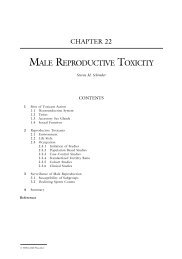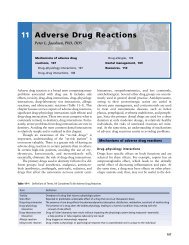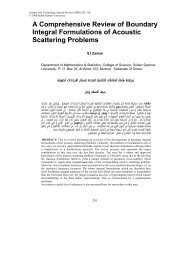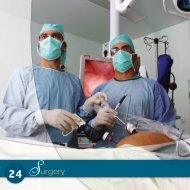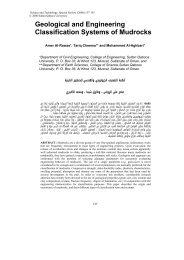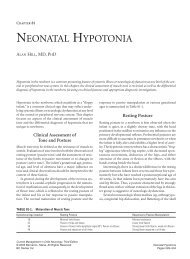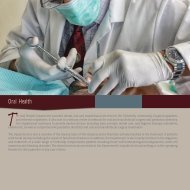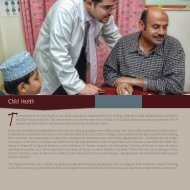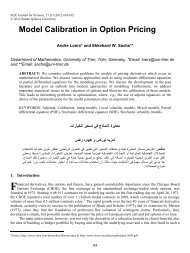Ch05: Red and White Lesions of the Oral Mucosa
Ch05: Red and White Lesions of the Oral Mucosa
Ch05: Red and White Lesions of the Oral Mucosa
You also want an ePaper? Increase the reach of your titles
YUMPU automatically turns print PDFs into web optimized ePapers that Google loves.
<strong>Red</strong> <strong>and</strong> <strong>White</strong> <strong>Lesions</strong> <strong>of</strong> <strong>the</strong> <strong>Oral</strong> <strong>Mucosa</strong> 109<br />
A B<br />
FIGURE 5-35 A, The essential microscopic features <strong>of</strong> lichen planus include hyperkeratosis, epi<strong>the</strong>lial atrophy, <strong>and</strong> a dense subepi<strong>the</strong>lial b<strong>and</strong> <strong>of</strong> lymphocytes.<br />
(Hematoxylin <strong>and</strong> eosin, ×40 original magnification) B, Also characteristic <strong>of</strong> lichen planus are saw-too<strong>the</strong>d rete ridges, liquefactive degeneration<br />
or necrosis <strong>of</strong> <strong>the</strong> basal cell layer, <strong>and</strong> separation <strong>of</strong> <strong>the</strong> epi<strong>the</strong>lium from <strong>the</strong> lamina propria. (Hematoxylin <strong>and</strong> eosin, ×65 original magnification)<br />
Differential Diagnosis<br />
Differential diagnosis <strong>of</strong> lichen planus must consider <strong>the</strong> range<br />
<strong>of</strong> o<strong>the</strong>r lichenoid lesions (eg, drug-induced lesions, contact<br />
mercury hypersensitivity, ery<strong>the</strong>ma multiforme, lupus ery<strong>the</strong>matosus,<br />
<strong>and</strong> graft-versus-host reaction), as well as leukoplakia,<br />
squamous cell carcinoma, mucous membrane pemphigoid,<br />
<strong>and</strong> c<strong>and</strong>idiasis. 173,175,180 A detailed history <strong>of</strong> <strong>the</strong> clinical<br />
appearance <strong>and</strong> distribution <strong>of</strong> <strong>the</strong> lesions is very helpful.<br />
Although it does not always provide an unequivocal diagnosis,<br />
a biopsy should be carried out before treatment <strong>of</strong> <strong>the</strong><br />
lesions, because <strong>of</strong> <strong>the</strong> tendency for corticosteroids to confuse<br />
<strong>the</strong> diagnosis. Asymptomatic reticular lichen planus is <strong>of</strong>ten left<br />
untreated, <strong>and</strong> biopsy is not usually performed. Biopsy <strong>of</strong> papular<br />
<strong>and</strong> plaquelike OLP should be performed to rule out dysplastic<br />
changes <strong>and</strong> leukoplakia. Biopsy is usually performed on<br />
<strong>the</strong> erosive <strong>and</strong> bullous forms, partly because <strong>the</strong>y are symptomatic<br />
(<strong>and</strong> thus brought to <strong>the</strong> clinician’s attention) <strong>and</strong> partly<br />
to differentiate <strong>the</strong>m from o<strong>the</strong>r vesiculobullous disorders. 181<br />
Clinical Course <strong>and</strong> Prognosis<br />
The lesions <strong>of</strong> OLP appear, regress, <strong>and</strong> re-appear in a somewhat<br />
unpredictable fashion. Andreasen 190 calculated that 41%<br />
<strong>of</strong> reticular lesions healed spontaneously whereas 12% <strong>of</strong><br />
atrophic lesions, 7% <strong>of</strong> plaquelike lesions, <strong>and</strong> 0% <strong>of</strong> erosive<br />
lesions healed without treatment. Silverman <strong>and</strong> Griffith 191<br />
reported that when observed longer than 1 year, approximately<br />
10% <strong>of</strong> a group <strong>of</strong> patients with predominantly erosive lesions<br />
had remissions. In a more recent, larger, <strong>and</strong> prospective study,<br />
Thorn <strong>and</strong> associates 181 reported that papular <strong>and</strong> ulcerative<br />
(erosive) changes were short-term lesions whereas atrophic<br />
<strong>and</strong> plaquelike changes were characterized by many remissions<br />
<strong>and</strong> newly developing lesions. Thorn <strong>and</strong> co-workers<br />
demonstrated that long-term topical steroid <strong>and</strong> antimycotic<br />
<strong>the</strong>rapy had no apparent effect on <strong>the</strong> course <strong>of</strong> <strong>the</strong> disease.<br />
Numerous reports have related lichenoid lesions to a contact<br />
sensitivity to mercury <strong>and</strong>, less <strong>of</strong>ten, gold <strong>and</strong> food flavorings.<br />
Removal <strong>of</strong> amalgam fillings in mercury-sensitive individuals<br />
who have contact-related lesions has almost always led to <strong>the</strong><br />
complete resolution <strong>of</strong> <strong>the</strong> disease or at least to significant<br />
improvement. 176,183<br />
It must be stressed that lichenoid lesions that are caused by<br />
a contact allergy to dental materials such as amalgam occur<br />
only directly opposite <strong>the</strong> restoration. In patients with lichen<br />
planus, <strong>the</strong> general removal <strong>of</strong> amalgam fillings that are not<br />
directly opposite a lesion is not justified.<br />
The status <strong>of</strong> OLP as a premalignant condition has been<br />
debated for many years. Numerous publications have described<br />
<strong>the</strong> clinical <strong>and</strong> histopathologic follow-up <strong>of</strong> lesions (in some<br />
cases, over many decades). 191–198 The occurrence <strong>of</strong> squamous<br />
cell carcinoma in most series ranges from 0.4 to 2.0% per 5-year<br />
observation period. 195 The most recent <strong>and</strong> extensive study<br />
reported a rate <strong>of</strong> 1.5% for patients observed over 7.5 years. 198<br />
These rates are similar to those quoted for malignant change in<br />
leukoplakia <strong>and</strong> represent some 50 times <strong>the</strong> rate for <strong>the</strong> general<br />
population. OLP fulfills <strong>the</strong> criteria for a “premalignant”<br />
condition <strong>and</strong> was so designated at <strong>the</strong> 1984 International<br />
Seminar on <strong>Oral</strong> Leukoplakia <strong>and</strong> Associated <strong>Lesions</strong> Related<br />
to Tobacco Habits. 136 Although malignant transformation is<br />
reported to be more likely in erosive lesions, possibly due to <strong>the</strong><br />
exposure <strong>of</strong> deeper layers <strong>of</strong> <strong>the</strong> epi<strong>the</strong>lium to oral environmental<br />
carcinogens, <strong>the</strong>re appears to be no consistent clue to<br />
<strong>the</strong> identity <strong>of</strong> those lesions that are likely to become malignant.<br />
Several investigators have described a lesion (referred to as oral<br />
lichenoid dysplasia) on <strong>the</strong> basis <strong>of</strong> a defined histopathologic<br />
picture <strong>and</strong> have postulated that this lesion is an independent<br />
precancerous lesion that mimics lichen planus <strong>and</strong> represents<br />
<strong>the</strong> true precursor <strong>of</strong> malignant change in lichen planus. 199,200<br />
There is no general agreement on <strong>the</strong> grading <strong>of</strong> lichen planus,<br />
ei<strong>the</strong>r clinically or histopathologically. Therefore, continued<br />
surveillance, repeated biopsy, <strong>and</strong> (where possible) eradication<br />
<strong>of</strong> erosive lesions <strong>and</strong> those lesions demonstrating dysplastic<br />
changes remain <strong>the</strong> safest course. Most cases <strong>of</strong> squamous cell





